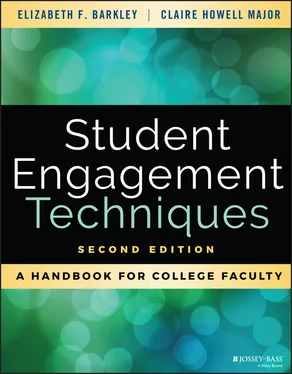Elizabeth F. Barkley - Student Engagement Techniques
Здесь есть возможность читать онлайн «Elizabeth F. Barkley - Student Engagement Techniques» — ознакомительный отрывок электронной книги совершенно бесплатно, а после прочтения отрывка купить полную версию. В некоторых случаях можно слушать аудио, скачать через торрент в формате fb2 и присутствует краткое содержание. Жанр: unrecognised, на английском языке. Описание произведения, (предисловие) а так же отзывы посетителей доступны на портале библиотеки ЛибКат.
- Название:Student Engagement Techniques
- Автор:
- Жанр:
- Год:неизвестен
- ISBN:нет данных
- Рейтинг книги:3 / 5. Голосов: 1
-
Избранное:Добавить в избранное
- Отзывы:
-
Ваша оценка:
- 60
- 1
- 2
- 3
- 4
- 5
Student Engagement Techniques: краткое содержание, описание и аннотация
Предлагаем к чтению аннотацию, описание, краткое содержание или предисловие (зависит от того, что написал сам автор книги «Student Engagement Techniques»). Если вы не нашли необходимую информацию о книге — напишите в комментариях, мы постараемся отыскать её.
— — — —
Student Engagement Techniques
"Student Engagement Techniques
"Student Engagement Techniques
"This book is an essential resource for faculty seeking to better engage with their students. Anyone seeking a clear, research-based, and actionable guide needs a copy of Student Engagement Techniques on their shelf!"
Student Engagement Techniques — читать онлайн ознакомительный отрывок
Ниже представлен текст книги, разбитый по страницам. Система сохранения места последней прочитанной страницы, позволяет с удобством читать онлайн бесплатно книгу «Student Engagement Techniques», без необходимости каждый раз заново искать на чём Вы остановились. Поставьте закладку, и сможете в любой момент перейти на страницу, на которой закончили чтение.
Интервал:
Закладка:
Learning is the creation of meaning from experience.
Learning is an accumulation of experience, which changes with new experiences and new situations.
Learning has happened when a student completes an authentic task that has significance for the learner.
The teacher's main job is to facilitate learning rather than deliver information.
Students should be encouraged to discover principles for themselves.
Students should solve realistic problems.
Students should apply classroom knowledge in new contexts.
Students should be allowed—even encouraged—to engage in free exploration within a given framework or structure.
Humanism
Humanists believe that learning is a personal act in which individuals seek knowledge and understanding in order to fulfill their own potential as well as expand their awareness of the human condition. They suggest that learning occurs through watching the behavior of others or studying significant works of the human intellect and imagination and then considering the results of those actions as they also cultivate an appreciation of human values and achievement. Humanists believe the purpose of learning is to enable learners to participate in social and cultural communities, understand and empathize with others, and appreciate the variety of perspectives and responses to the human condition.
From the humanist perspective, effective teachers design opportunities for learners to increase their self-awareness and to practice thinking critically, especially the ability to make reasoned judgments that reflect ethical and esthetic human values. Humanist theories of learning tend to be value-driven, and several instructional approaches have been developed that reflect those values, including approaches such as critical pedagogy (Freire), service learning, and authentic learning activities. Humanists tend to believe that:
Learning is a personal act to fulfill development.
The teacher's job is to employ strategies that facilitate the development of the whole person and to serve as a model of appropriate behavior.
Learners are responsible for their own learning and should learn to self-regulate.
Teachers should strive to encourage learner autonomy and learners should be given a choice in the tasks they undertake.
The teacher can tell when learning has happened through a learner's demonstrated self-actualization and autonomy.
A Perspective from Neuroscience
Neuroscientists are making remarkable discoveries that help us understand what happens within our brains when we are learning. To better understand how learning occurs, it is useful to have at least a fundamental understanding of its neurological basis. There are now several books that explain the brain's functioning to educators and general audiences, and the following is a synthesis of information provided in several of these sources (Diamond & Hopson, 1998; Ratey, 2002; Sousa, 2006; Wlodkowski, 2008) as well as in Barkley, Major, and Cross (2014) and Cross (1999). The brain is comprised of cells called neurons. Neurons start out as round cell bodies, but then each cell body grows as many as 100,000 short branches called dendrites as well as a single long root known as an axon. Neurons act like tiny batteries, receiving information through the dendrites, sending it as a signal down the axon where chemicals called neurotransmitters are “fired” across a gap called the synapse to be received by the dendrites of another neuron. As the neurotransmitter enters the dendrites of a neighboring neuron, it sparks a series of electro-chemical reactions that cause the receiving neuron also to “fire” through its axon. The process and reactions continue in a sequence until there is a pattern of neuronal connections firing together.
Bombarded with thousands of stimuli that create these events every moment of our lives, neurons stay in a state of readiness for hours or even days. If the pattern is not stimulated again, the neuronal network will decay and the perception will be lost. This occurs so that our brain does not get cluttered with useless information. If, on the other hand, the pattern is repeated during this standby period and the associated network of neurons fires together again, the web of connections becomes more permanent. Each neuron and its thousands of neighbors intertwine to form an extraordinarily complex, interconnected tangle consisting of about 100 trillion constantly changing connections. Through repetition, some connections are strengthened and we “learn,” while connections that are seldom or never used are eliminated and we “forget.”
Thus, dendrites are the main way by which neurons get information (learn), the axon is the main way the neuron sends the information (teach), and everything we know and understand has been preserved as a network of neurons in our brain. When adults learn, we build on or modify networks that have been created through previous learning and experience. If the new information fits easily with the old information, it is said to be assimilated. If the new information challenges the existing information sufficiently that the existing structure needs to be revised, it is said to be accommodated (Svinicki, 2004, p. 11). The more dendrites an individual has on which to hang or attach new information, the easier it is to learn and retain new information. The greater number of basic neuronal networks an individual has, the easier it is to form more complex networks. From a neuroscientific viewpoint, therefore, learning is long-lasting change in neurons and existing neuronal networks. When we promote active learning, we are helping students grow dendrites as well as activate and build upon existing neuronal networks.
What Factors Influence Learning?
Different theorists clearly have different ideas about what factors influence learning. But there are some factors from the perspective of cognitive science that we find particularly salient for the concept of student engagement. In the following sections, we outline these factors.
Schemata
A schema, or in plural form schemata, is a cognitive structure that consists of facts and ideas organized into a meaningful system of relationships. Cross (1999) described the concept as follows:
A schema is a cognitive structure that consists of facts, ideas, and associations organized into a meaningful system of relationships. People have schemata for events, places, procedures, and people, for instance. Thus, a schema is an organized collection of bits of information that together build the concept of the college for each individual. When someone mentions the college, we “know” what that means, but the image brought to mind may be somewhat different for each individual. (p. 8)
Our brains have schemata for events, places, procedures, and people. Schemata change and grow as new events, filtered by perception into the schema, are organized and connected to the existing structure to create meaning. One can readily imagine the “rich” schema that would be in the mind of someone who had taught at or attended a specific college (including, for example, memories of courses, classrooms, professors, and so forth) and contrast it with the relatively sparse schema of someone who had simply heard of the college. The potential for errors and misunderstanding is also readily apparent as one considers the kinds of erroneous connections that would result if the person confuses the college with another college with a closely related name or a college that has the same name but is in a different state.
The value of a well-developed schema is revealed in research on the differences between the learning of novices and experts. For the expert in any subject, new information is quickly grasped in useable form because connections to existing knowledge are numerous. The learning of a novice, in contrast, is labored and slow, not because the novice is less intelligent than the expert but because connections between new information and existing schemata are sparse—there are no hooks on which to hang the new information, no way to organize it (Cross, 1999, p. 8; de Groot, 1966).
Читать дальшеИнтервал:
Закладка:
Похожие книги на «Student Engagement Techniques»
Представляем Вашему вниманию похожие книги на «Student Engagement Techniques» списком для выбора. Мы отобрали схожую по названию и смыслу литературу в надежде предоставить читателям больше вариантов отыскать новые, интересные, ещё непрочитанные произведения.
Обсуждение, отзывы о книге «Student Engagement Techniques» и просто собственные мнения читателей. Оставьте ваши комментарии, напишите, что Вы думаете о произведении, его смысле или главных героях. Укажите что конкретно понравилось, а что нет, и почему Вы так считаете.












